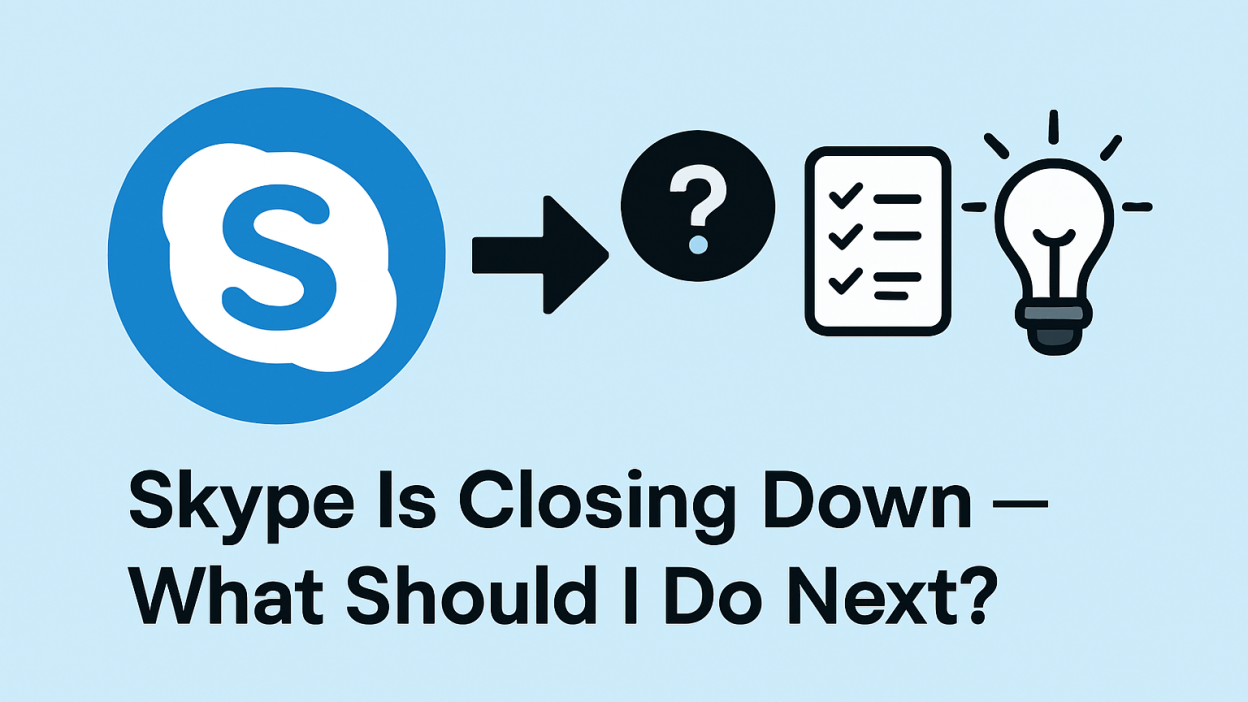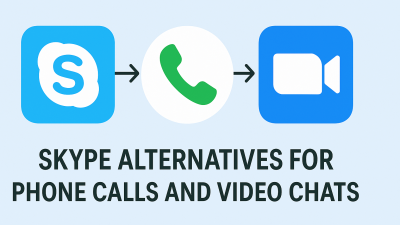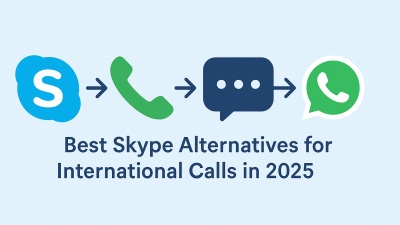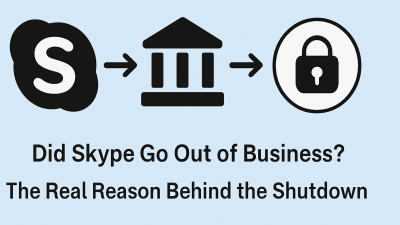If you’ve used Skype for any period, the May 5th shutdown notice probably hits harder than you’d expect. Not because of nostalgia, although there’s some of that, but because Skype worked.
It worked for calling relatives who don’t “do apps.”
It worked for making cheap international calls that didn’t eat your mobile data.
It worked when WhatsApp didn’t. Or when Zoom felt like overkill. Or when you didn’t want to explain how to use yet another new platform.
So no, this isn’t just an announcement about retiring old software. It’s the closing of something that fit neatly into people’s lives for reasons tech companies often overlook: simplicity, affordability, and trust.
And now, with just weeks left before Skype stops functioning, the question isn’t just, “What’s replacing it?”, it’s, “What actually works for how I live and communicate?”
Why Microsoft Is Retiring Skype — And What That Means for You
Microsoft’s decision to shut down Skype isn’t random. It’s part of a broader strategy to streamline its communication tools under a single brand: Microsoft Teams.
From a company’s perspective, this makes sense. Teams is scalable, integrated into Microsoft 365, and positioned as the “future of collaboration.” Skype, by contrast, was a separate, aging codebase that didn’t quite fit into Microsoft’s long-term infrastructure.
But here’s the catch — Teams was never built for the things Skype did best.
It wasn’t built for casual check-ins.
It wasn’t built for spontaneous voice calls to landlines abroad.
It wasn’t built for the non-technical users who just want a clean interface and a call button that works.
So while Microsoft wants you to see this as a “transition,” it’s more accurate to think of it as a fork in the road. You’re not just being nudged into an upgraded Skype — you’re being offered a completely different platform, one with very different priorities.
Which means you need to decide what matters most to you before jumping ship.
Why Teams Might Not Be the Right Fit for Everyone

Let’s get specific.
If you work remotely, collaborate across time zones, or use Microsoft tools all day, Teams probably makes sense. It connects to everything: your calendar, your documents, your meetings, your chat history.
But if you’re the kind of person who used Skype for personal calls, the kind that didn’t involve links, agendas, or shared whiteboards, Teams might feel more like a boardroom than a phone line.
The interface is built for managing digital workspaces. Even the language, “channels,” “teams,” “assignments”, leans corporate. For someone who just wants to hear their uncle’s voice in another country, that kind of layout can be distracting, even frustrating.
What’s more, many of Skype’s most practical features, like the international Dial Pad, don’t translate well into Teams, especially for new users. If you never needed productivity features, you might find yourself clicking through tabs, wondering where the “call” part went.
That’s not a knock against Teams. It’s a solid platform. But it’s not a direct replacement for Skype’s core purpose: making simple, global communication accessible to everyone.
What Will Disappear on May 5th
Let’s be very clear: Skype is not going into the background. It’s not entering “limited support” mode. It’s shutting down completely.
After May 5th, the app will stop working on desktop, mobile, and web. You won’t be able to log in, call anyone, or access your chat history.
Any Skype Credit you still have will expire.
Your conversations will no longer be available unless you’ve backed them up.
And any contact who hasn’t moved to another platform will effectively vanish from your list.
Microsoft will still offer Teams Free, but it requires re-onboarding. You’ll need to download a new app, sign in again, and accept that the layout and flow are fundamentally different.
For some people, that’s fine. But for others, especially those who aren’t tech-savvy or who use Skype as a phone alternative, this creates real disruption.
What You Can Do Right Now to Stay in Control
First, understand that this transition doesn’t have to catch you off guard. There’s still time to act, and acting now means staying connected on your terms.
You can:
-
Export your Skype chat history and files
-
Notify the people you talk to most often that you’re switching
-
Use any remaining Skype Credit while it still holds value
-
Try out your next platform before you need it, so you’re not scrambling later
But most importantly, this is the moment to ask yourself: “What kind of calling experience do I want going forward?”
Because while Microsoft would prefer you move to Teams, that’s not the only or best option for everyone.
You’re Not Just Losing an App — You’re Losing a Lifeline
The real impact of Skype shutting down isn’t the disappearance of an icon from your desktop. It’s the breakdown of routines that felt dependable. The aunt you called every Sunday night. The overseas client you checked in with every other week. The relative in Pakistan who doesn’t use WhatsApp. The call that cost you pennies didn’t drop, and just worked.
For millions of people, Skype was never about productivity or collaboration. It was about reaching across borders without breaking the bank, and without needing both parties to use the same smartphone app.
And that’s exactly where MyTello steps in, not to replicate every feature of Skype, but to double down on the one that mattered most: effortless international calling that respects your time, money, and mental bandwidth.
What Is MyTello — and Why Is It So Different?
MyTello isn’t trying to be everything. It’s not a messenger. It’s not a workspace. It’s not an all-in-one platform.
It’s a dedicated international calling service that lets you:
-
Call landlines and mobile numbers in over 200 countries
-
Pay per minute at incredibly low rates (often cheaper than Skype ever was)
-
Use any phone — smartphone, landline, or feature phone
-
Call from anywhere, with or without Wi-Fi
You don’t need the person you’re calling to install anything. No app. No invite. No explaining to your grandmother how to swipe or accept a video call.
You just dial, connect, and talk, the way people still need to.
How MyTello Works (In Plain Language)
There are two ways to use MyTello, both designed to be simple.
-
From a smartphone or computer (using VoIP):
-
Log into your account at mytello.com or use the app
-
Choose the country you’re calling
-
Dial the number
-
The call connects over the internet, using very little data
-
-
From a regular phone (no data needed):
-
MyTello gives you a local access number
-
You call that number, then dial your international number when prompted
-
The rest of the call is routed internationally by MyTello at their low per-minute rate
-
This means even if you’re on a limited mobile plan or calling from a landline, you’re not locked out. You’re not dependent on the other person having tech. And you’re not trapped in a software ecosystem that doesn’t respect how you use communication tools.
What Skype Did Well — And Where MyTello Picks Up
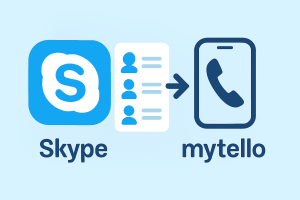
Skype had three real strengths:
-
International dialing without SIM cards or international plans
-
Calls to real numbers, not just usernames
-
Affordable, pre-paid calling options
And while Microsoft Teams absorbs Skype’s chat and video features, it completely leaves behind its global voice-calling power, especially for people who don’t want to be forced into Microsoft’s wider 365 platform.
That’s the gap. And it’s where MyTello isn’t just a stand-in, it’s a step forward.
With rates starting from 1 cent per minute, and coverage in countries that matter most to the people who relied on Skype (India, Pakistan, Philippines, Nigeria, Eastern Europe, Latin America), MyTello is built around real-life calling behavior, not software trends.
Why It’s Not Just About Cost — It’s About Control
Skype worked because it let users control their communication: no contracts, no bundles, no pressure to subscribe. MyTello keeps that same model alive.
You create a free account. You top up only when you need to. You use it how and when you want. And you get crystal-clear call quality because it doesn’t route everything through the bloated app logic of a messenger or meeting tool.
Unlike some free apps that come with ads, data harvesting, or forced contacts syncing, MyTello keeps it clean. You’re paying for the call, not selling your attention in exchange for access.
Who MyTello Is Perfect For
It’s not for everyone. But if any of these sound like you, it might be exactly what you need:
-
You regularly call parents, grandparents, or family abroad, and they use regular phones, not apps
-
You need to reach mobile or landline numbers for work or support, not usernames
-
You’re a migrant, student, or expat who used Skype as a phone line, not a chat app
-
You care about cost, but not at the expense of call quality
-
You don’t want to explain how to “join a meeting” just to say goodnight
This is especially powerful in places where access to smartphones is inconsistent or where older generations haven’t transitioned to app-based communication. MyTello puts those people back within reach, without complications.
Getting Started with MyTello Is Actually Simple
You don’t have to wait for Skype to disappear before making the switch.
You can:
-
Visit mytello.com
-
Create a free account in minutes
-
Choose your country and top up your balance (only what you need)
-
Start calling right away, from your phone or browser
There’s no monthly fee. No contract. No commitment. You try it, and if it fits, you stay.
What People Are Saying After Switching
Users who’ve moved from Skype to MyTello often say the same thing: “Why didn’t I know about this sooner?”
They talk about how calls connect faster. Voice clarity is more consistent. And how not having to explain another app to an aging parent or a distant cousin is worth everything.
For people who just want to call, not configure, it’s a rare return to common sense.
Final Thoughts: Replace the Function, Not the App
Skype is closing, yes. But your ability to connect globally doesn’t have to suffer. You don’t have to squeeze your needs into the mold of a productivity platform. You don’t have to settle for apps built for someone else’s lifestyle.
You can replace Skype with something built for your world, where calls still matter, where simplicity still wins, and where every ring, every connection, still feels personal.
That’s what MyTello offers. Not as a nostalgia play, but as a real, modern solution that respects what Skype users used Skype for.

